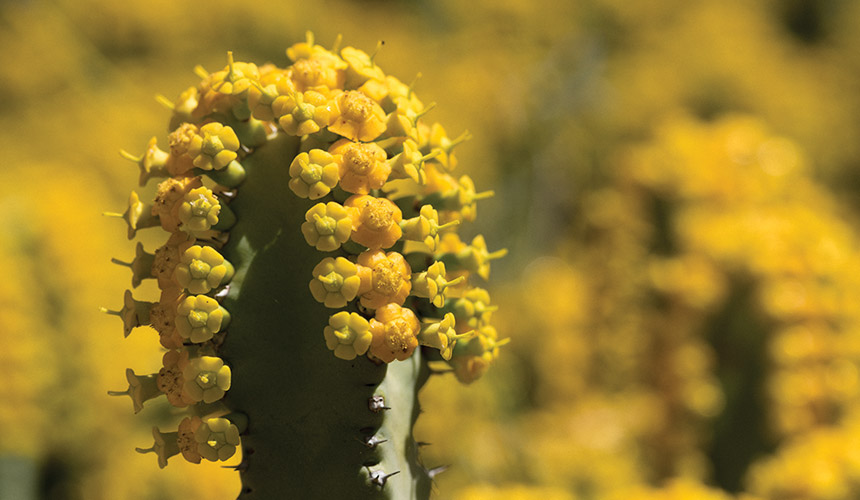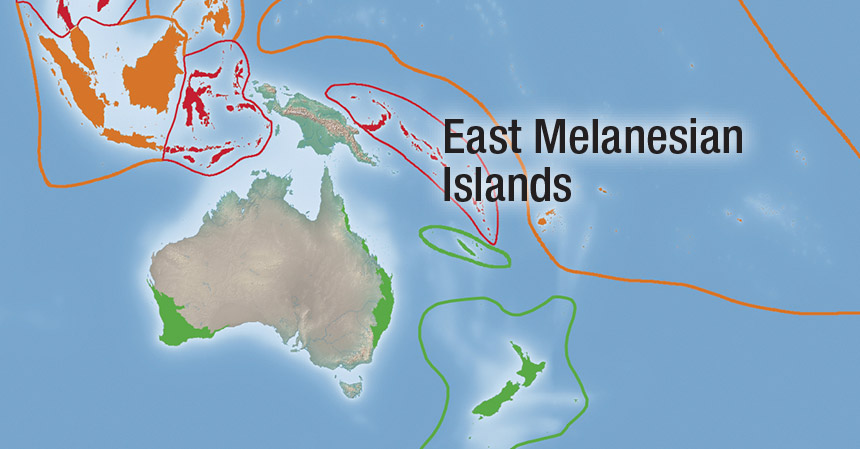Backing Nature-Based Solutions to Climate Change
Given the prognosis for more frequent catastrophic weather events in the region, these forest monitoring plots will help track forest recovery, and determine the role of native and invasive species in this process. These insights can make substantial contributions to the ability of resource managers and policymakers in Vanuatu and the Pacific Island region to support environmental and community recovery, adaptation and resiliency.
Protection and restoration of tropical forests and other ecosystems could make up 30 percent of the greenhouse gas emission reductions necessary to avoid climate disaster that would disproportionately affect the poor, according to climate experts. CEPF supports projects that protect or restore natural forests, wetlands and coastal zones as cost-effective means for mitigating the potentially devastating effects of climate change and extreme weather.
East Melanesian Islands Biodiversity Hotspot
In March 2015, Cyclone Pam, a Category 5 storm with sustained winds of 280 km/h (175 mph), swept across the Pacific Island nation of Vanuatu, killing people, flattening homes, destroying crucial crops, and crippling infrastructure. A CEPF-funded project managed collaboratively by the New York Botanical Garden (NYBG) and local partner agencies was on the ground on Tanna Island, conducting baseline surveys of plant diversity, when the storm made a direct hit.
“Island floras—and peoples, too—are particularly susceptible to catastrophic events, and increased resilience and self-sufficiency are essential to maintaining livelihoods into the future,” said Michael J. Balick, NYBG project co-principal investigator. “But cumulative impacts in places like Vanuatu are making them increasingly vulnerable to the imminent effects of global change—social, economic, and environmental.”
In the aftermath of Cyclone Pam, the project team—including staff and students of the Vanuatu Department of Forests, local cultural organization Tafea Kaljoral Senta, the University of the South Pacific (USP), and NYBG—in close partnership with local community members, recognized the need to set aside some portion of the communities’ forests to help preserve ecosystem services, especially water, over the long term. The partners worked first to identify forested areas that were also sources of clean water, and then helped install new water supply systems that would also protect these biodiversity-rich, intact forest habitats.
The project also has a strong focus on documenting plant biodiversity in Tafea Province, as well as the indigenous names and uses of these plants. All field studies have been conducted in partnership with local communities across Tanna and more recently on Aneityum, with plans to expand efforts to other nearby islands. “We were very moved by the extraordinarily strong interest in this project expressed by leaders and members of the local communities, and their remarkable willingness to collaborate and contribute to the on-the-ground activities,” said Gregory M. Plunkett, NYBG project co-principal investigator.
Before Cyclone Pam, eight long-term ecological forest monitoring transects had been established on Tanna Island and surveyed by the international team of researchers. They resurveyed the plots eight months after the storm and will continue to do so at regular intervals during the planned decade-long timeline of the project. This work will provide information about the processes of ecosystem regeneration and forest resilience in the face of global change.
The project also has a major focus on building local scientific capacity, including training students and foresters. These activities will ultimately enable local people themselves to conserve and sustain their natural and biocultural heritage.
Mediterranean Basin Biodiversity Hotspot

Morocco’s High Atlas Mountains are teeming with thousands of plant species, hundreds of which are found nowhere else on Earth. The remote and largely self-sustaining indigenous communities in the region depend on these plants, both to sell and for sustenance and medicinal use. But climate change-exacerbated droughts and floods, along with overharvesting and livestock overgrazing, have had a serious negative impact on this fragile ecosystem.
In response, CEPF grantee Global Diversity Foundation (GDF) chose two communities for a pilot project that aimed to improve local livelihoods while simultaneously reducing the pressure on the mountain flora.
“We are trying to develop best practices that can be disseminated to other communities,” said Mohamed Aboufirass, general director of the hydrology and environmental engineering firm Resing, which joined GDF and other partners to implement the project.
First, the organization produced a study of the medicinal and endemic species to use as a baseline for evaluating the impact of the project’s other activities. Then project participants established nurseries that house endemic species alongside income-generating ones. Community members are now able to collect plants from the nursery and harvest them for their own needs.

By building new water basins, repairing traditional water canals and setting up drip irrigation systems, the project both enabled the irrigation of more land and extended the irrigation season by two to three weeks.
This shift to more efficient use of water for domestic and agricultural needs leaves sufficient water in the ground to nurture the revival of healthy vegetation in the area. As climate change is predicted to further reduce water availability in the High Atlas, maximizing water efficiency will be essential if families are to continue to make a living in the mountains.
Photo Credits
Community members demonstrate new water system. © New York Botanical Garden
Project participants work at plant nursery, Imegdale, Morocco. © Inanc Tekguc, for Global Diversity Foundation
Euphorbia resinifera O.Berg, Azilal, Morocco. © Inanc Tekguc, for Global Diversity Foundation






